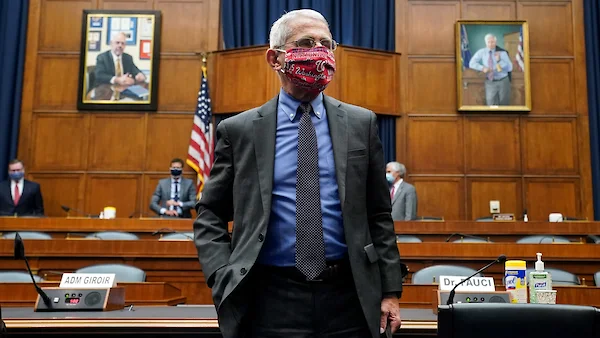
While the U.S. awaits a new COVID-19 spike, President Donald Trump campaigns with jokes about the “Chinese virus.”
Despite the gradual recovery of the American economy following epidemiological restrictions due to COVID-19, the pandemic remains a serious threat to the United States. The country’s chief infectious disease specialist, Anthony Fauci, along with his colleagues, warned U.S. lawmakers about this, saying that the next two weeks will be “critical” in controlling the disease. President Donald Trump, however, prefers not to notice the warnings.
The US Will Never Rise from Its Knees
COVID-19 has “brought this nation to its knees,” said Robert Redfield, director of the Centers for Disease Control and Prevention, testifying along with Fauci and other public health experts before Congress. According to Redfield, COVID-19 will force the United States to incur costs in the total amount of $7 trillion. He also noted that nursing homes — where both residents and employees are dying — bear the brunt of the disease, as they account for almost 40% of all deaths from COVID-19. “Over half of the nursing homes in this nation right now, over 7,000 nursing homes in this nation, have a COVID patient in them,” Redfield stated.
Fauci, director of the National Institute of Allergy and Infectious Diseases, in turn warned of “a disturbing surge of infections.” As of June 24, more than 2.3 million infections had been reported, as well as 121,000 deaths. He stated that “the next couple of weeks are going to be critical in our ability to address those surges we are seeing in Florida, Texas, Arizona, and other states.”
The state of Texas, for example, reported a record daily increase of 5,500 infected people the day before. Republican Gov. Greg Abbott admitted that the situation could take a threatening turn.
“If we were to experience another doubling of those numbers over the next month, that would mean we are in an urgent situation where tougher actions will be required,” Abbott said. Arizona and Florida residents are being increasingly warned that if the infection rate does not change, the public health system may collapse.
However, as Fauci correctly noted, states besides those he named are experiencing problems: in 25 states the infection rate is increasing (while it remains stable in 12 states and decreases in 13, as Washington slowly withdraws restrictions).
Fauci offered this advice to Americans: “Plan A: Don’t go in a crowd. Plan B: If you do, make sure you wear a mask.” He also recommended that at universities — many of which plan to open in November — masks should be mandatory and constantly worn by everyone, and that the most vulnerable groups (elderly professors and students with preexisting conditions) should work remotely.
The infectious disease specialist expressed hope that a vaccine will become available at the end of 2020 or beginning of 2021.
In response to a question posed by Republican Rep. David McKinley, Fauci said that in his opinion, everyone in the White House is doing everything necessary to combat the COVID-19 epidemic. He did not mention President Trump specifically.
Arizona Cowboy
“Kung flu?” Trump cheerfully asked attendants of a rally in Phoenix, Arizona, which took place on the same day as the congressional hearing on COVID-19. It is worth noting that the rally took place indoors, and on the same day that Arizona reported a record increase in the number of cases (almost 3,600). Approximately 3,000 people attended the president’s rally; contrary to the Democratic mayor’s request. No one’s temperatures were taken and nearly no masks were worn.
“Kung flu” is one of the president’s new nicknames for COVID-19. He referred to the Chinese martial art of kung fu and combined it with the English word “flu,” which is a form of SARS. At the rally, however, Trump hardly spoke about the virus itself, although the phrase “kung flu” generated applause. Instead he claimed that “the plague” is “going away,” promised the availability of a vaccine soon, and blamed “the fake news media people” for escalating the situation. Among his base, the president chose to focus on waging an ideological war with his opponents.
“They hate our history. They hate our values and they hate everything we prize as Americans,” Trump proclaimed to those gathered. “And we’re right, because our country didn’t grow great with them. It grew great with you and your thought process and your ideology. The left wing mob is trying to demolish our heritage so they can replace it with a new repressive regime that they alone control.” He expressed particular satisfaction with the dispersion of protesters who had tried to dismantle the statue of the United States’ seventh president, Andrew Jackson: “If you give power to people that demolish monuments and attack churches and seize city streets, and set fire to buildings, then nothing is sacred and no one is safe,” Trump said.
From the president’s point of view, the choice is clear: “This is a choice of two futures. The left’s vision of disunity and discord, or our vision of equal opportunity and equal justice.”
According to aggregated campaign data from RealClearPolitics, for the time being, residents of Arizona are inclined to choose what the president considers the future of “disunity and discord:” on average, Democrat Joe Biden’s rating is 4% higher than that of Trump.
It is worth noting that the most recent survey conducted by CNBC and Change Research represents Biden’s lead in Arizona as only 1%, while voters’ preference of him in the national arena is as high as 10%.

Leave a Reply
You must be logged in to post a comment.